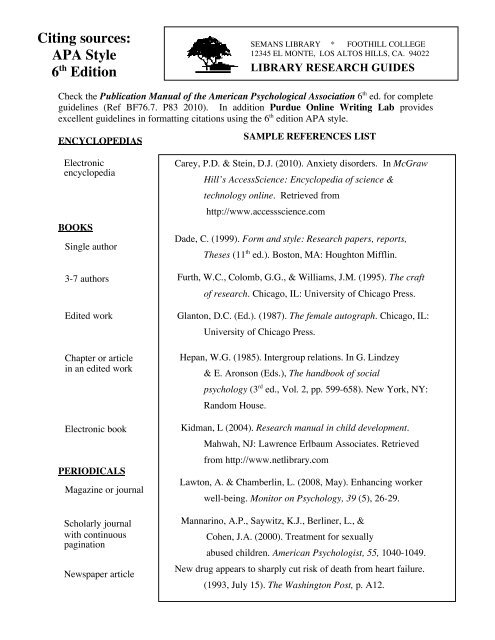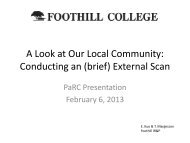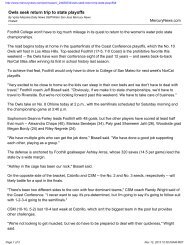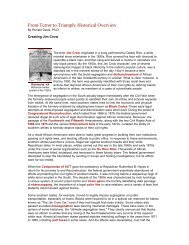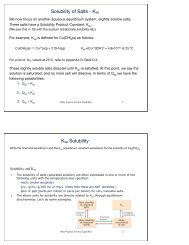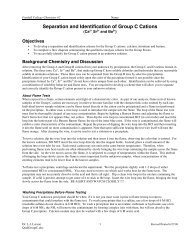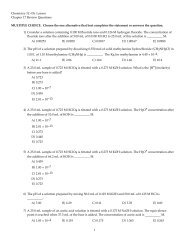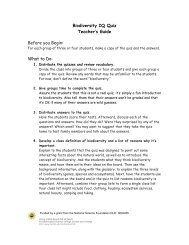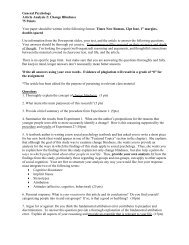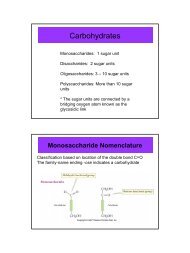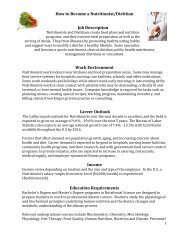Citing sources: APA Style 6th Edition - Foothill College
Citing sources: APA Style 6th Edition - Foothill College
Citing sources: APA Style 6th Edition - Foothill College
Create successful ePaper yourself
Turn your PDF publications into a flip-book with our unique Google optimized e-Paper software.
<strong>Citing</strong> <strong>sources</strong>:<br />
<strong>APA</strong> <strong>Style</strong><br />
6 th <strong>Edition</strong><br />
Check the Publication Manual of the American Psychological Association 6 th ed. for complete<br />
guidelines (Ref BF76.7. P83 2010). In addition Purdue Online Writing Lab provides<br />
excellent guidelines in formatting citations using the 6 th edition <strong>APA</strong> style.<br />
ENCYCLOPEDIAS<br />
Electronic<br />
encyclopedia<br />
BOOKS<br />
Single author<br />
3-7 authors<br />
Edited work<br />
Chapter or article<br />
in an edited work<br />
Electronic book<br />
PERIODICALS<br />
Magazine or journal<br />
Scholarly journal<br />
with continuous<br />
pagination<br />
Newspaper article<br />
Carey, P.D. & Stein, D.J. (2010). Anxiety disorders. In McGraw<br />
Hill’s AccessScience: Encyclopedia of science &<br />
technology online. Retrieved from<br />
http://www.accessscience.com<br />
Dade, C. (1999). Form and style: Research papers, reports,<br />
Theses (11 th ed.). Boston, MA: Houghton Mifflin.<br />
Furth, W.C., Colomb, G.G., & Williams, J.M. (1995). The craft<br />
of research. Chicago, IL: University of Chicago Press.<br />
Glanton, D.C. (Ed.). (1987). The female autograph. Chicago, IL:<br />
University of Chicago Press.<br />
Hepan, W.G. (1985). Intergroup relations. In G. Lindzey<br />
& E. Aronson (Eds.), The handbook of social<br />
psychology (3 rd ed., Vol. 2, pp. 599-658). New York, NY:<br />
Random House.<br />
SEMANS LIBRARY * FOOTHILL COLLEGE<br />
12345 EL MONTE, LOS ALTOS HILLS, CA. 94022<br />
LIBRARY RESEARCH GUIDES<br />
SAMPLE REFERENCES LIST<br />
Kidman, L (2004). Research manual in child development.<br />
Mahwah, NJ: Lawrence Erlbaum Associates. Retrieved<br />
from http://www.netlibrary.com<br />
Lawton, A. & Chamberlin, L. (2008, May). Enhancing worker<br />
well-being. Monitor on Psychology, 39 (5), 26-29.<br />
Mannarino, A.P., Saywitz, K.J., Berliner, L., &<br />
Cohen, J.A. (2000). Treatment for sexually<br />
abused children. American Psychologist, 55, 1040-1049.<br />
New drug appears to sharply cut risk of death from heart failure.<br />
(1993, July 15). The Washington Post, p. A12.
PERIODICALS<br />
Article from a<br />
database<br />
Journal article<br />
with DOI (digital<br />
object identifier)<br />
INTERNET<br />
Journal article with<br />
home page URL<br />
Web site article<br />
Ong, C. & Egwuonwu, O. (2010). Why culture will become<br />
crucial for success in 2010. Advertising Age, 81(5), 14.<br />
Retrieved from Academic Search Premier database. *<br />
Park, K.R. & Kensinger, E.A. (2009). Phenomenological<br />
characteristics of emotional memories. Memory, 17,<br />
528-543. doi: 10.1080/09658210902939363<br />
Simpson, T. (2006). A world of pain: Scientists explore factors<br />
controlling pain perception. JAMA: Journal of the<br />
American Medical Association, 296, 2425-2427. Retrieved<br />
from http://jama.ama-assn.org<br />
Tooby, J. (1997, January13). Evolutionary psychology. Retrieved<br />
from UCSB Center for Evolutionary Psychology web site:<br />
http://www.psych.ucsb.edu/research/cep/primer.html<br />
*To facilitate the location of <strong>sources</strong>, we have chosen to retain the name of the database rather than<br />
following the 6 th edition guidelines, which call for using a DOI (digital object identifier) or periodical<br />
home page URL or database home page URL.<br />
CITATIONS IN THE TEXT<br />
Citations in the text are a basic part of every research paper. Any time you use a direct quote, paraphrase<br />
something you have read, or use a specific idea or fact from your reading, you need to cite the source.<br />
<strong>APA</strong> style uses in-text citations to refer the reader to the specific bibliographic citation in the list of<br />
References. Citations are placed in the body of your paper, following the specific part of the text to<br />
which they apply. If the in-text citation is at the end of a sentence, place it before the period. To cite a<br />
specific book or article, use the author’s last name, followed by the year of publication. If there is no<br />
author listed, use the first few words of the title in quotes. To cite a direct quote or give credit for<br />
something such as summarized information, a chart or graph, include author’s name and specific page<br />
number (p.) or numbers (pp.). If no page number is visible, cite the author, year, section heading (if<br />
applicable) and paragraph number.<br />
<strong>Citing</strong> a book or article: (Waller, 2001)<br />
<strong>Citing</strong> a source with no author: (“Separation Anxiety,” 2007)<br />
<strong>Citing</strong> a specific quote: (French, 1963, p. 25)<br />
<strong>Citing</strong> a specific quote from a web page: (Jones, 2008, Discussion section, para. 3)<br />
REFERENCES LIST<br />
SAMPLE REFERENCES LIST<br />
All <strong>sources</strong> used or cited are listed at the end of your paper on a separate numbered page with the<br />
heading, References, centered at the top. Each source is listed alphabetically by the first author’s last<br />
name or the first significant word of the title (where there is no author or editor). References entries are<br />
double-spaced. The first line of each reference is not indented. Subsequent lines are indented using a<br />
hanging indent or a half-inch indention.<br />
IF YOU NEED MOR INFORMATION ABOUT <strong>APA</strong> STYLE – ASK A LIBRARIAN<br />
6/10js


